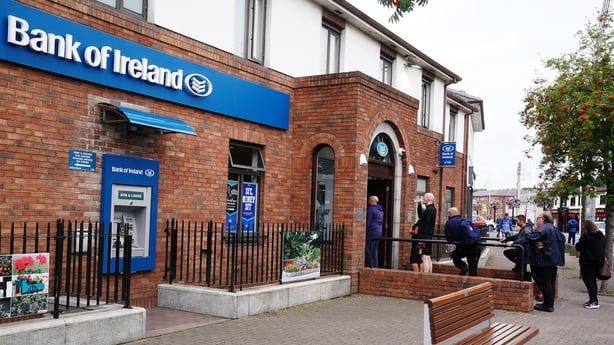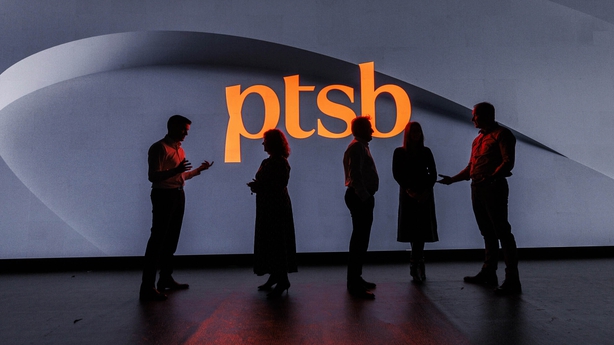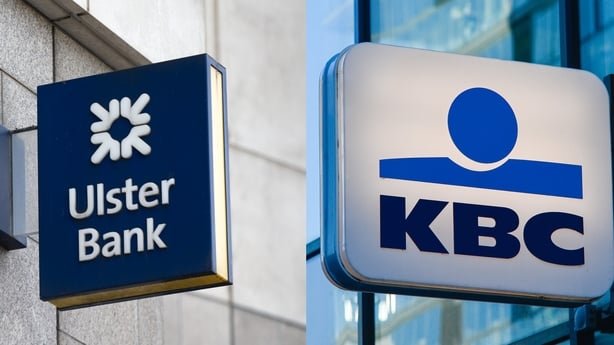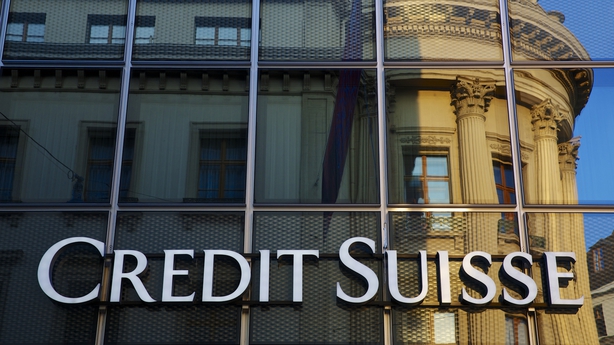Rising interest rates boost Irish banks’ profits

In the world of Irish banking, 2023 was really all about one thing – rising interest rates.
After a long period of historically low and even negative rates, the European Central Bank began a fresh round of increases in July of 2022.
Once that trend started, it continued right through 2023, with the monetary policymakers in Frankfurt adding a further 2% to the main deposit rate, on top of the cumulative 2.5% in hikes of the year before.
For the Irish banks, this meant one thing – bonanza profits.
Net interest income – the money made from interest producing products after the interest costs attached to them are deducted – soared, driving margins higher.
After reporting €1.2 billion in full-year profits for 2022 in March, Bank of Ireland went on to chalk up a half year profit for 2023 in July of just over €1 billion as the real effects of higher rates, coupled with its broadened customer base arising from the acquisition of KBC loans, was felt.

Over at AIB, it was a similar story.
After it booked a full-year profit of €765m for 2022, a 98% increase in net interest income led it to almost double its after tax profit for the first half to €854m.
In the summer PTSB (so-called since its re-branding in October) followed its two larger competitors in revising upwards its guidance for the year, after it reported a pre-tax profit of €26m for the first six months of the year off an expanded customer base and interest rate increases.
The year was peppered with sporadic interest rate increases by the banks, each one carefully calculated to try to maintain competitive advantage.
For quite a period, variable rates remained untouched, with fixed mortgage products where most of the customer demand lay, edging steadily higher instead.
Yet, despite the march upwards, mortgage rates at the Irish banks did not climb as high or as quickly as those of many lenders in other EU countries.
By the end of October (the most recent month for which data is available) the average new mortgage rate in Ireland stood at 4.27%, the eighth highest rate among euro zone countries – but still only 20 basis points above the euro area average.
The reasoning for the Irish banks’ approach appeared to be three-fold. First, with two significant players in Ulster Bank and KBC leaving the Irish market and the interest rate environment changing, there was plenty of customer switching going on.
For the three main remaining retail banks, that presented an opportunity to sweep up new customers if they could remain competitive on their lending rates.
Second, the Irish retail banks remain mindful of their public perception – and in the case of AIB and PTSB their part Government ownership.

In that context, rapidly and aggressively hiking rates to the full extent possible would not have been a good look, as it would have hit the country’s 720,000 mortgage holders hard and led to a significant spike in arrears.
“The Irish banks are good at reading the political tea leaves and it is not hard to remember that mortgage pricing has been a bit of a headline item in the media for the best part of the last ten years,” said an industry source.
“The Irish population is very sensitive to the fact that mortgage prices were higher than in other countries in the eurozone for a very long period,” the source said.
“So had they passed on to the full extent the base rate increases, there could have been consternation. And secondly, I think it is also helpful in a loan loss containment context,” it added.
Also, throughout the year Irish banks remained awash with customers’ pandemic savings – so much so that they did not need to borrow from the ECB to the same extent as their European peers in order to fund their lending.
This gave AIB, Bank of Ireland and PTSB some freedom to set their own mortgage lending rates, as they weren’t borrowing on expensive wholesale markets, and in turn allowed them to keep rates lower than they might have gone.
But it also proved a double-edged sword, because it meant the Irish lenders didn’t need or want to attract more savings in.
For this reason and their desire to make up for some of the interest earning potential that they were missing out on by having mortgage rates lower than they needed to be, the banks were slow to pass the full ECB interest rate hikes to depositors.
The most recent Central Bank data shows that on average term deposits in Irish banks were attracting an interest rate of 2.59% in October, well below the euro zone average of 3.27%.
The situation led to growing criticism of the banks as the year went on, as customers complained they weren’t getting a fair return on their savings, even though inertia meant many continued to hold their money in the lowest yielding demand deposit or current accounts.
“Headline deposit rates have increased at a higher pace relative to new mortgage rates in Ireland,” said Diarmaid Sheridan, banking analyst at Davy.
“Yet, the majority of deposits continues to be held in current accounts and notice accounts and customer behaviour is closely watched but has not shown any great change,” Mr Sheridan said.
“This is at odds with market expectations that official rates have peaked and will start coming down,” he added.
Despite the pressure, to date Irish lenders have continued with this strategy of trying to balance off the benefits of slightly lower rates for mortgage customers with the knock-on lower rates for savers, while at the same time trying to make the most of the profitable landscape to keep shareholders happy – something which may not last.
“Bank profitability, driven by growth in interest margins, has risen rapidly this year,” Central Bank Governor Gabriel Makhlouf said in a speech in November.
“We must be clear-eyed in our assessment that this will not last forever. There are significant risks to the outlook, including increases in financial distress, a repricing in global and local commercial real estate markets, weakening loan growth and increased funding costs. In light of these headwinds, this is a time to be prudent,” he said.
Those profits have brought the issue of distributions back into focus though, as AIB and Bank of Ireland shareholders await signs of bigger future paydays than they have enjoyed in the recent past.
At PTSB, the December lifting by the Central Bank of the block on the payment of dividends opened the door to the resumption of the payment of dividends.

“Looking into 2024, dividends which have not been big features of the investment cases for Irish banks in recent years will now begin to come to fore,” said Diarmaid Sheridan of Davy.
“Irish banks are over capitalised and profitability has improved materially which supports higher levels of dividends and buy-backs in the coming years. In the case of AIB this will benefit the State as the buyback will reduce the State shareholding,” he added.
That State stake in AIB did drop markedly during the year, following a directed share buyback in April that saw 1% of the State’s holding sold back to the bank and two further placings in June and November that disposed of 5% each.
It successfully brought the State’s ownership level down to 40.8%, below the key majority threshold, and raised €1.2 billion, leaving the door firmly ajar for further disposals in 2024 if the share price holds up.
Perhaps spurred on by the process at AIB, the Minister for Finance also announced in June that he had started something similar at Permanent TSB.
This time, a placing of shares in tandem with another large shareholder NatWest (which took ownership of a chunk of PTSB as part of its sale of Ulster Bank assets to it), resulted in 5% of the State’s stake being sold, bringing it down to 57.4% and raising €55.2m in the process for the Exchequer.
“I think at PTSB you could see more transactions next year, potentially,” said John Cronin, banking analyst at Goodbody Stockbrokers.
“It is unlikely that NatWest sees PTSB as a core investment. So you could see more action there next year,” he added.
Over at Bank of Ireland, where the State had sold the last of its shareholding in September 2022, the loosening of the influence led to changes in remuneration policies.
Following the Government’s lifting last December of some of the restrictions around bankers’ pay, Bank of Ireland said in February it would reintroduce performance-based bonuses for staff in 2024, capped at €20,000 a year due to continuing Government restrictions, and later announced a new health benefit contribution.
But to get around the ongoing restrictions on performance based variable pay, it also emerged that it planned to make sizeable share awards to its top management that are not linked to performance.
Still under the watchful eye of a big Government shareholder, AIB didn’t go that far, but did announce in October that it plans to introduce performance-based bonuses of up to €12,700 per employee in 2024, plus healthcare benefits.
As yet, Permanent TSB has not yet outlined its plan on variable pay.
It, perhaps, was too busy bedding in its €6.2 billion acquisition of various assets of the departing Ulster Bank.

In February, following a quick refresh, it reopened the 25 branches it acquired from Ulster Bank in various locations around the country, bringing its network to 98.
In May it completed the transfer of around 8,000 performing non-tracker mortgages worth €915m that it bought from Ulster Bank, following the transfer of €5.2 billion in loans the previous November.
It was a similar situation at AIB and Bank of Ireland, where new customers added through the Ulster Bank and KBC loan sales and the wider “Big Switch” of 2022 were settled in.
In January the competition watchdog gave AIB permission to go-ahead with its purchase of Ulster Bank’s €5.7 billion tracker book.
All told, it was a much calmer year on the Irish banking front, compared to the three previous frenetic years.
There was, however, a period of heightened concern and nervousness in March caused by the collapse of Silicon Valley Bank (SVB) and worries about the wider health of the US banking system.
That spread much closer to home on 19 March, when UBS agreed to buy an ailing Credit Suisse for 3 billion Swiss francs and up to 5 billion francs in assumed losses in a rescue orchestrated by Swiss authorities.

Despite worries here about contagion, the declaration by the banks and the Government that the Irish lenders were well capitalised and not exposed to the kind of specific risks and problems that brought down SVB and Credit Suisse proved to be accurate.
“Significant turmoil in the US banking system largely by-passed European banks, with the very notable exception of Credit Suisse which had a large number of issues which it ultimately couldn’t surmount,” said Diarmaid Sheridan.
“This demonstrates the significant changes to the regulatory landscape that European banks operate to now, with little or no impact on banks funding or capital positions from the event of March,” he stated.
Nonetheless, the episode did go to underline the still inherent fragility of certain parts of the global banking system, the speed at which crises of confidence can spread and deposits can move, and the need for ongoing strong intrusive regulation.
The drama may also perhaps have fed further into the growth of non-traditional neo-banks and fintechs, as people look to alternative ways of handling their money.
Certainly, here in Ireland, Revolut continued its ascendency, growing its user base to 2.5 million and adding a variety of new services and products, including car insurance, credit cards and a promise to begin offering mortgages.
In April it also completed the rollout of Irish IBANs to its customers, bringing it another step further down the road in its quest to compete head-on with traditional banks.

Its task was helped by the decision in November of AIB, Bank of Ireland and PTSB to scrap their plan to roll out a shared mobile based instant payments platform, Synch, to rival Revolut, after they learned in July that they would need a higher level of Central Bank authorisation than initially thought.
Credit unions also received a boost during 2023, with the passing of legislation that will enhance their abilities to do and offer more.
The law will enable the movement to expand their range of services and to facilitate all members to access mortgages, business loans and current account services.
It will also allow smaller credit unions that do not provide services such as mortgages or SME loans to refer members to branches that do.
They are, therefore, looking towards a positive 2024, after a year which saw lending from Irish League of Credit Unions affiliates grow by €555m to €5.3 billion.
Also hopeful of a new year bounce will be non-bank lenders, like Finance Ireland and ICS/Dilosk who endured a tricky 12 months as interest rates rose and the bond markets where they raise capital became tough.
New entrant MoCo and another provider that is expected to launch in the New Year should add some fresh and much needed competition to the mortgage market.
In truth though, despite the positive gains made in 2023, 2024 is still shaping up to be another challenging one for Irish banks, non-bank lenders and fintechs.
“Looking forward, clearly 2023 was an extraordinary year – I do see a lot of resilience from a revenue perspective in 2024,” said John Cronin, banking analyst at Goodbody Stockbrokers.
“But there are some challenges on the horizon, like base rate reductions will probably manifest at some point during ’24, certainly that is what the market is pricing, which will cause some erosion in interest margins,” he said.
The economic outlook also remains challenging and risks, including from two ongoing wars, climate change and a faltering commercial property market remain high.
But having made it through three extraordinary years relatively unscathed, lenders in the Irish market are likely to feel, perhaps with some justification, that they are now ready to handle just about anything.





